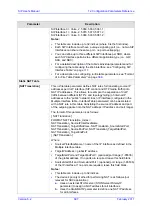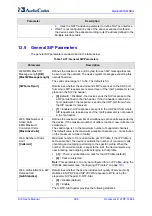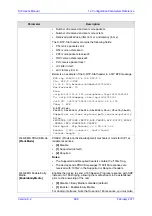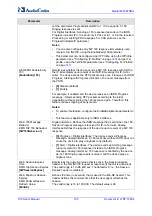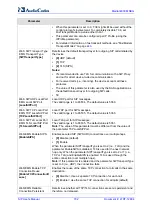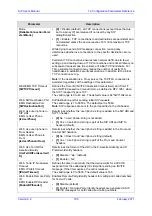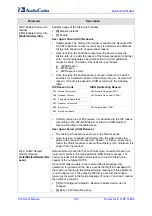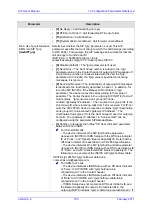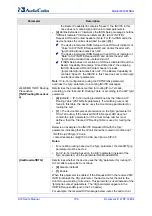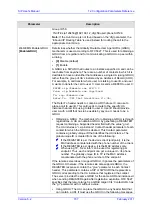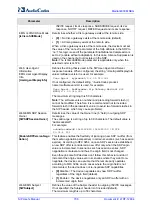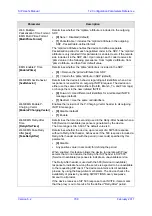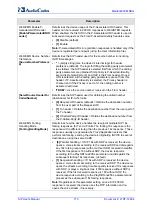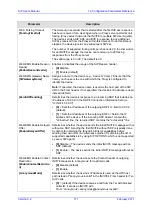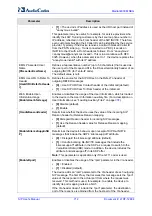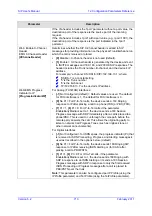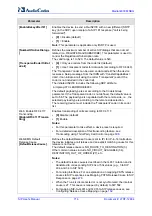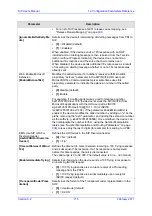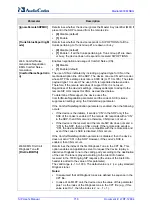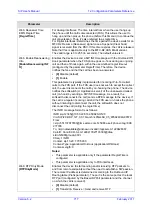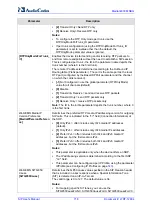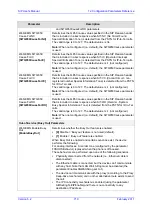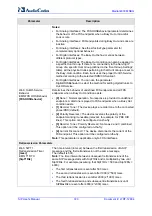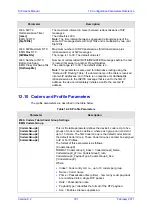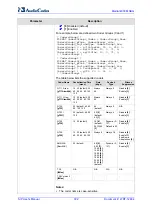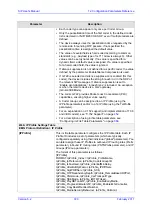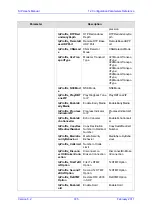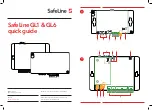
SIP User's Manual
710
Document #: LTRT-12804
Mediant 800 MSBG
Parameter
Description
Web/EMS: Enable P-
Associated-URI Header
[EnablePAssociatedURIH
eader]
Determines the device usage of the P-Associated-URI header. This
header can be received in 200 OK responses to REGISTER requests.
When enabled, the first URI in the P-Associated-URI header is used in
subsequent requests as the From/P-Asserted-Identity headers value.
[0]
Disable (default).
[1]
Enable.
Note:
P-Associated-URIs in registration responses is handled only if the
device is registered per endpoint (using the User Information file).
Web/EMS: Source Number
Preference
[SourceNumberPreferenc
e]
Determines the SIP header used for the source number in incoming
INVITE messages.
''
= (empty string) Use the device's internal logic for header
preference (default). The logic for filling the calling party parameters
is as follows: the SIP header is selected first from which the calling
party parameters are obtained: first priority is P-Asserted-Identity,
second is Remote-Party-ID, and third is the From header. Once a
URL is selected, all the calling party parameters are set from this
header. If P-Asserted-Identity is selected, the Privacy header is
checked and if the Privacy is set to 'id', the calling number is
assumed restricted.
'FROM'
= Use the source number received in the From header.
[SelectSourceHeaderFor
CalledNumber]
Determines the SIP header used for obtaining the called number
(destination) for IP-to-Tel calls.
[0]
Request-URI header (default) = Obtains the destination number
from the user part of the Request-URI.
[1]
To header = Obtains the destination number from the user part of
the To header.
[2]
P-Called-Party-ID header = Obtains the destination number from
the P-Called-Party-ID header.
Web/EMS: Forking
Handling Mode
[ForkingHandlingMode]
Determines how the device handles the receipt of multiple SIP 18x
forking responses, for Tel-to-IP calls. The forking 18x response is the
response with a different to-tag than the previous 18x response. Those
responses usually are generated by Proxy/Application servers that
perform call forking, sending the device's originating INVITE to several
destinations, using the same CallID.
[0]
Parallel handling = If SIP 18x with SDP is received, the device
opens a voice stream according to the received SDP and disregards
any 18x forking responses (with or without SDP) received thereafter.
If the first response is 180 without SDP, the device responds
according to the PlayRBTone2TEL parameter and disregards the
subsequent forking 18x responses. (default)
[1]
Sequential handling = If 18x with SDP is received, the device
opens a voice stream according to the received SDP. The device re-
opens the stream according to subsequently received 18x responses
with SDP, or plays a ringback tone if 180 response without SDP is
received. If the first received response is 180 without SDP, the
device responds according to the PlayRBTone2TEL parameter and
processes the subsequent 18x forking responses.
Note:
Regardless of this parameter setting, once a SIP 200 OK
response is received, the device uses the RTP information and re-
opens the voice stream, if necessary.
Summary of Contents for Mediant 800 MSBG
Page 2: ......
Page 366: ...SIP User s Manual 366 Document LTRT 12804 Mediant 800 MSBG Reader s Notes ...
Page 372: ...SIP User s Manual 372 Document LTRT 12804 Mediant 800 MSBG Reader s Notes ...
Page 390: ...SIP User s Manual 390 Document LTRT 12804 Mediant 800 MSBG Reader s Notes ...
Page 404: ...SIP User s Manual 404 Document LTRT 12804 Mediant 800 MSBG Reader s Notes ...
Page 616: ...SIP User s Manual 616 Document LTRT 12804 Mediant 800 MSBG Reader s Notes ...
Page 636: ...SIP User s Manual 636 Document LTRT 12804 Mediant 800 MSBG Reader s Notes ...
Page 652: ...SIP User s Manual 652 Document LTRT 12804 Mediant 800 MSBG Reader s Notes ...
Page 886: ...SIP User s Manual 886 Document LTRT 12804 Mediant 800 MSBG Reader s Notes ...


